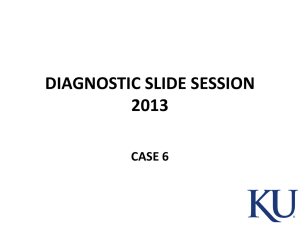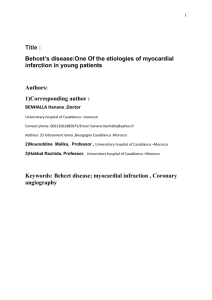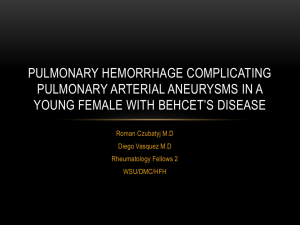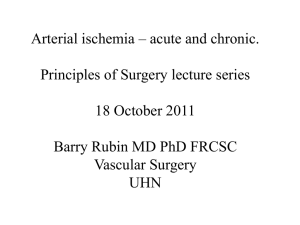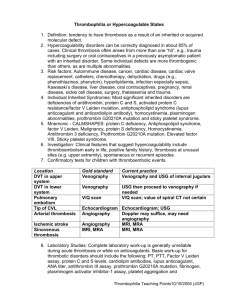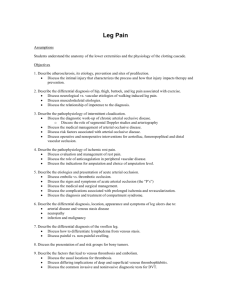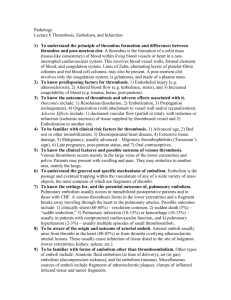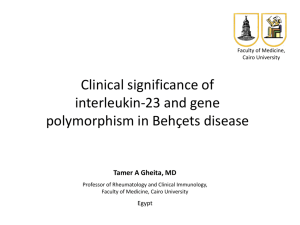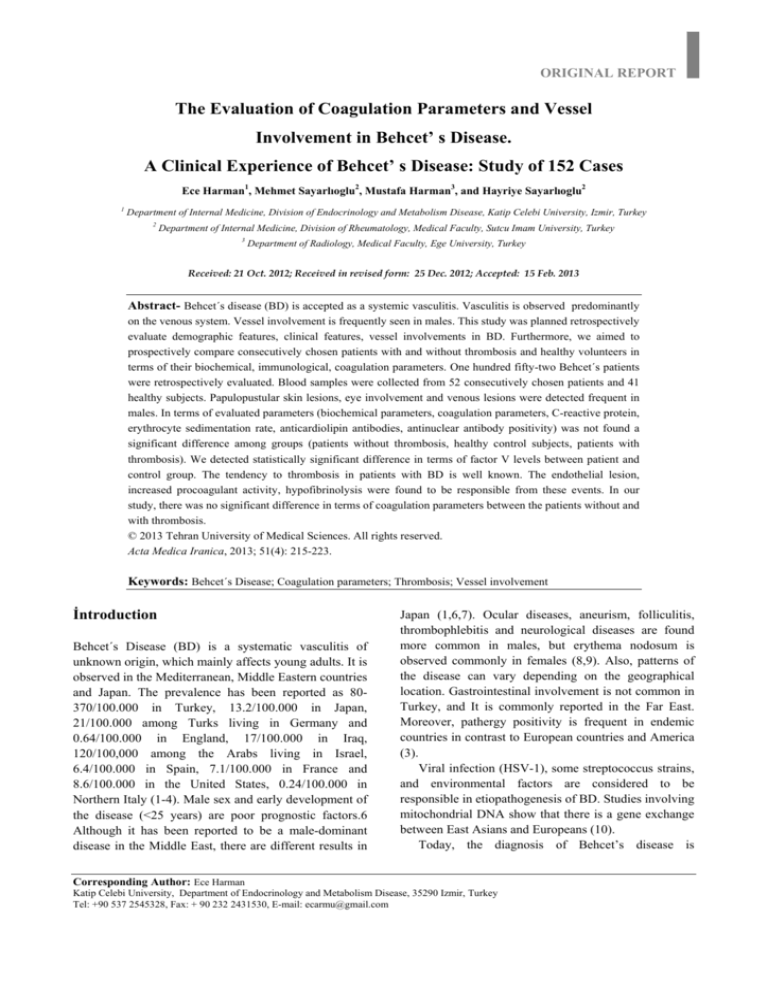
ORIGINAL REPORT
The Evaluation of Coagulation Parameters and Vessel
Involvement in Behcet’ s Disease.
A Clinical Experience of Behcet’ s Disease: Study of 152 Cases
Ece Harman1, Mehmet Sayarlıoglu2, Mustafa Harman3, and Hayriye Sayarlıoglu2
1
Department of Internal Medicine, Division of Endocrinology and Metabolism Disease, Katip Celebi University, Izmir, Turkey
2
Department of Internal Medicine, Division of Rheumatology, Medical Faculty, Sutcu Imam University, Turkey
3
Department of Radiology, Medical Faculty, Ege University, Turkey
Received: 21 Oct. 2012; Received in revised form: 25 Dec. 2012; Accepted: 15 Feb. 2013
Abstract- Behcet´s disease (BD) is accepted as a systemic vasculitis. Vasculitis is observed predominantly
on the venous system. Vessel involvement is frequently seen in males. This study was planned retrospectively
evaluate demographic features, clinical features, vessel involvements in BD. Furthermore, we aimed to
prospectively compare consecutively chosen patients with and without thrombosis and healthy volunteers in
terms of their biochemical, immunological, coagulation parameters. One hundred fifty-two Behcet´s patients
were retrospectively evaluated. Blood samples were collected from 52 consecutively chosen patients and 41
healthy subjects. Papulopustular skin lesions, eye involvement and venous lesions were detected frequent in
males. In terms of evaluated parameters (biochemical parameters, coagulation parameters, C-reactive protein,
erythrocyte sedimentation rate, anticardiolipin antibodies, antinuclear antibody positivity) was not found a
significant difference among groups (patients without thrombosis, healthy control subjects, patients with
thrombosis). We detected statistically significant difference in terms of factor V levels between patient and
control group. The tendency to thrombosis in patients with BD is well known. The endothelial lesion,
increased procoagulant activity, hypofibrinolysis were found to be responsible from these events. In our
study, there was no significant difference in terms of coagulation parameters between the patients without and
with thrombosis.
© 2013 Tehran University of Medical Sciences. All rights reserved.
Acta Medica Iranica, 2013; 51(4): 215-223.
Keywords: Behcet´s Disease; Coagulation parameters; Thrombosis; Vessel involvement
İntroduction
Behcet´s Disease (BD) is a systematic vasculitis of
unknown origin, which mainly affects young adults. It is
observed in the Mediterranean, Middle Eastern countries
and Japan. The prevalence has been reported as 80370/100.000 in Turkey, 13.2/100.000 in Japan,
21/100.000 among Turks living in Germany and
0.64/100.000 in England, 17/100.000 in Iraq,
120/100,000 among the Arabs living in Israel,
6.4/100.000 in Spain, 7.1/100.000 in France and
8.6/100.000 in the United States, 0.24/100.000 in
Northern Italy (1-4). Male sex and early development of
the disease (<25 years) are poor prognostic factors.6
Although it has been reported to be a male-dominant
disease in the Middle East, there are different results in
Japan (1,6,7). Ocular diseases, aneurism, folliculitis,
thrombophlebitis and neurological diseases are found
more common in males, but erythema nodosum is
observed commonly in females (8,9). Also, patterns of
the disease can vary depending on the geographical
location. Gastrointestinal involvement is not common in
Turkey, and It is commonly reported in the Far East.
Moreover, pathergy positivity is frequent in endemic
countries in contrast to European countries and America
(3).
Viral infection (HSV-1), some streptococcus strains,
and environmental factors are considered to be
responsible in etiopathogenesis of BD. Studies involving
mitochondrial DNA show that there is a gene exchange
between East Asians and Europeans (10).
Today, the diagnosis of Behcet’s disease is
Corresponding Author: Ece Harman
Katip Celebi University, Department of Endocrinology and Metabolism Disease, 35290 Izmir, Turkey
Tel: +90 537 2545328, Fax: + 90 232 2431530, E-mail: ecarmu@gmail.com
The evaluation of coagulation parameters in Behcet’s disease established in accordance with the criteria determined by
the International Study Group (ISG) in 1990 (11). Oral
aphthous ulcers are the initial and most common
symptom of the disease. However, genital ulcers are the
second most common symptom of the disease. Ocular
lesions (anterior uveitis, cataract, posterior uveitis, and
retinal vasculitis) are seen in 50% of the patients (in
males and younger patients) (12). Central nervous
system involvement (parenchymal/vascular) is seen
more often than peripheral nerve or muscle
involvements (3). Neurologic involvement appears more
often in European and American patients (9,13).
Behcet´s disease is a vasculitis which can affect
vessels of all types and sizes. Vascular involvement
occurs more often in males and is the most common
cause of death in young male patients. Approximately,
in 25% of the patients there are large arterial and venous
vessel involvement (15). Vascular involvement patterns
can be in the form of superficial thrombophlebitis, deep
vein thrombosis, and occlusion and aneurisms of larger
arteries. Venous involvement is more frequent
(approximately 20-40%) according to arterial
involvement. Vessel involvement usually occurs in the
first five years of the disease. Thrombosis can be
detected in the subclavian, femoral, popliteal, hepatic
vein, cerebral venous sinus (16). Vena cava thrombosis,
pulmonary arterial aneurysm, dural sinus thrombosis,
and abdominal aorta aneurysms appear with descending
frequency (17). Pulmonary arterial aneurysm, the BuddChiari syndrome, and vena cava thrombosis are linked to
increased mortality. Superficial thrombophlebitis may
appear along with inferior vena cava and lower
extremity deep vein thrombosis. Vasculitis developing
by immunological mechanisms causes endothelium
activation and thus, It can occur the predisposition for
thrombosis (18). Arterial involvement is a rare
occurrence compared to venous involvement and can
have more serious results.
Males have arterial
involvement more common. The common arterial
involvement type is aneurysm, and It recurs often after
surgery (19). Arterial aneurisms have a high risk for
mortality. Generally, arterial aneurisms appear in the
aorta and pulmonary arteries. Behcet´s disease is the
most frequent acquired cause of pulmonary arterial
aneurysms (16). It can cause fatal hemoptysis in young
male patients. Pulmonary arterial aneurysms are often
bilateral, and there are accompanying to venous
thrombosis in 80% of these patients. Intracardiac
thrombosis is rare, and It can be detected located in the
right ventricle among the young male patients.
It is believed that endothelial activation linked to
216
Acta Medica Iranica, Vol. 51, No. 4 (2013)
vasculitis is responsible for the predisposition to
thrombosis (18) Fibrinolysis is associated with some
procoagulant gene mutations, hyperactive coagulation,
hypoactive anticoagulant mechanisms. Thus, these
mechanisms may result in the predisposition to
thrombosis. The heterozygote factor V Leiden mutation
and heterozygote prothrombin gene mutation frequency
has been reported as 37.5% and 31.3% among Behcet´s
patients, respectively. There are detected hereditary
prothrombotic mutations in about 56% of Behcet´s
patients. It suggest that there is a possible relationship
between the development of thrombosis and gene
mutations (20-23). Briefly, immunological defect and
consequently endothelial activation rather than primary
degeneration are responsible for thrombosis. Conditions
such as endothelial damage, increased procoagulant
activity, hyperfibrinolysis may contribute thrombosis.
Materials and Methods
One hundred and fifty-two patients were diagnosed
"Behcet´s Disease" according to the criteria of the
International Study Group. These patients were
retrospectively evaluated in terms of demographics,
clinical features and types of vessel involvement. All
subjects gave their informed consent to the study
protocol that was
conducted according to the guidelines of the
Declaration of Helsinki, and had been approved by the
local Ethic Committee. The blood samples were
collected from 52 Behcet´s patients who were selected
sequentially and 41 healthy volunteers. Types of
vascular involvement were recorded.
Superficial
thrombophlebitis was identified with clinical findings
(pain along the vein, swellings, and nonbacterial
inflammations). Deep vein thromboses were detected
using venography and angio-computed tomography,
Doppler ultrasonography (Toshiba SSA 27AA, Tokyo,
Japan). Aneurysms and/or some thrombotic lesions
were evaluated using computed tomography (HITACHI
W 450, Tokyo, Japan), angiography (AXIOM MULTI
STAR SIEMENS, Germany), and angio-computed
tomography.
The blood samples were placed in tubes containing
3.2% citrate, they were centrifuged at 3000 rotations for
10 minutes. The plasma samples were evaluated in terms
of coagulation parameters (prothrombin time, activated
partial thromboplastin time, fibrinogen, international
normalized ratio, Protein C, Protein S, Activated protein
C resistance, factor V, antithrombin) by using the fully
automatic coagulation machine “STA Compact”. The
E. Harman, et al.
Von Willebrant factor was measured quantitatively
(Liatest vWF TAMPON/Buffer vWF Latex). The
Anticardiolipin antibodies (ACA) were analyzed using
the fully automatic “THA-HD4” microeliza tool with the
“AESKULIZA Cardiolipin-GM, REF 7204” kit. The
samples were placed in contact with the “BIOCHIP”
slides for antinuclear antibodies evaluation (ANA). The
evaluation was conducted with fluorescent microscopy.
In the statistical evaluation, the group distribution was
found to be normal using the One-Sample KolmogorovSmirnov test. The “independent t” test was used to
determine the significant difference between the groups.
The values of P<0.05 were deemed significant.
Arithmetic means were calculated using standard
methods.
Results
In our study, there were 152 patients with Behcet´s
disease. It was detected 69 female patients, 83 male
patients. The mean age of the patients and the control
group were 32.48±8.88 (years) and 31.9±11.86 (years),
respectively. There was no significant difference for
mean ages between patients and control group (Table 1).
Similarly, there was not a significant difference in terms
of age between gender.
The family histories of our patients contained
Behcet´s disease, Familial Mediterranean Fever,
Ankylosing
Spondylitis,
Rheumatoid
Arthritis
(respectively; 15.1%, 1.3%, 1.3%, 1.3). Clinical findings
of the patients were evaluated (Table 2). Clinical
features such as papulopustular skin lesions, ocular
involvement, posterior uveitis and loss of vision were
detected in male patients. There was a significant
difference between genders in terms of these findings
(P<0.05). It was detected vascular involvement in 17.8%
of the patients (n=27). The mean age of onset was
23.78±8.97 (years) for patients with vascular
involvement.
Table 1. Demographical findings of the Behcet´s patients and the control group.
Demographical findings
Male/Female ratio
Mean age (years)
Mean age of onset (years)
Mean age of diagnosis (years)
The duration between the onset and
diagnosis (months)
Behcet´s diseases (n=152)
1.2
32.48±8.88
24.61±8.08
28.66±8.25
46.45±47.69
Control group (n=41)
0.8
31.9±11.86
-
Table 2. Evaluation of the clinical findings in the patient group.
Clinical findings which were positive at the time of
diagnosis
Oral aphthae
Genital ulcers
Extragenital ulcers
Dermatological manifestations
Papulopustular lesions
Erythema nodosum
Uveitis
Arthritis
Arthralgia
Thrombophlebitis
Cardiac involvement
Lung involvement
Central nervous system involvement
Aneurism
Gastrointestinal system involvement
Thrombosis
Pathergy
Total
152
112
5
122
103
47
37
24
16
19
0
0
0
0
1
4
49
(n=152)
(100%)
(73.7%)
(3.3%)
(80.3%)
(67.8%)
(30.9%)
(24.3%)
(15.8%)
(10.5%)
(12.5%)
(0%)
(0%)
(0%)
(0%)
(0.7%)
(2.6%)
(32.2%)
Acta Medica Iranica, Vol. 51, No. 4 (2013) 217 The evaluation of coagulation parameters in Behcet’s disease Table 3. Demographical findings of patients with deep vein thrombosis, locations of the thrombosis and methods of
screening.
Mean age of onset (years)
Mean age of diagnosis (years)
Duration from onset to diagnosis (months)
Portal vein thrombosis
Right main femoral vein thrombosis
Right internal jugular- right tibialis posterior vein thrombosis
Right internal jugular-right axillary- right subclavian vein thrombosis
Left femoral-left popliteal vein thrombosis
Right popliteal vein thrombosis
Right main femoral–saphenous vein thrombosis
Left popliteal vein thrombosis
Doppler ultrasonography
Venography
Aneurysms
(n=3),
thrombosis
(n=9),
thrombophlebitis (n=25), thrombosis accompanying
thrombophlebitis (n=9) was detected. Twenty-two of 27
patients with vessel involvement were male (81.5%),
and 5 of 27 patients were female (18.5%). There was a
significant difference between genders (P=0.002).
Twenty-four patients had venous involvement and 3
patients had arterial involvement. In male patients was
found venous involvement dominance (P=0.01). There
was no difference between patients with and without
vessel involvement in terms of clinical features. Nine of
the 152 Behçet´s patients had deep vein thrombosis.
Demographical findings of these patients, locations of
thrombosis and the screening methods are demonstrated
below (Table 3).
Behcet´s patients with superficial thrombophlebitis
were evaluated, and It was detected 25 patients (21 male
patients, 4 female patients). It was shown aneurysm in 1
female and 2 male patients. Ages of diagnosis in patients
with aneurysms were found 10 (years) (female), 37
(years) (male) and 31 (years) (male). The locations of
the aneurysm were detected as the abdominal aorta and
the left iliac artery (in the female patient), the ascending
aorta (in first male patient), the right popliteal artery and
the deep femoral artery (in other male patient).
There was a significant difference in terms of factor
V levels between 52 Behcet´s patients and 41 healthy
(P<0.05). It was not detected significant difference
between patients and control group in terms of other
parameters (uric acid, triglyceride, total cholesterol,
HDL, LDL and VLDL), hemoglobin, hematocrit,
platelet counts, prothrombin time, activated partial
218
Acta Medica Iranica, Vol. 51, No. 4 (2013)
Total (n=9)
Male/female ratio: 8/1
24.78±8.98
27.89±7.59
20.56±14.01
2 (22.2%)
1 (11.11%)
1 (11.11%)
1 (11.11%)
1 (11.11%)
1 (11.11%)
1 (11.11%)
1 (11.11%)
8 (88.89%)
1 (11.11%)
thromboplastin
time,
fibrinogen,
International
normalized ratio, Protein C, Protein S, Activated protein
C resistance, antithrombin III, Von Willebrand factor,
C-reactive protein, erythrocyte sedimentation rate,
anticardiolipin antibodies, and antinuclear antibody
positivity). Moreover, there was no significant
difference detected between patients with or without
thrombosis in terms of their biochemical parameters,
coagulation parameters, C-reactive protein, erythrocyte
sedimentation rate, anticardiolipin antibodies, and the
antinuclear antibodies. Also, there was no significant
relationship between patients with or without thrombosis
in terms of tobacco use.
Discussion
Male/female ratio was 1.2 in our study. It was detected
male predominance in other countries (Asia, Middle
East and Mediterranean countries) (24). In a recent study
conducted in the United States, It was reported a high
incidence among women (25). The male/female ratio
was 1.03 in a study conducted in Turkey by Tursen et al.
(26) and It is reflect the general situation for
Mediterranean countries.
In our study, the mean age of onset for Behçet´s
disease was 24.6 (years). Clinical features such as
papulopustular skin lesions, ocular involvements,
posterior uveitis, loss of vision, and vascular
involvement were found to be more common among
males. In terms of neurological, articular, and
gastrointestinal system involvement, there was no
significant difference between male and female. In the
E. Harman, et al.
studies conducted, the age of onset for Behçet´s disease
was reported as the 20s. Bang et al. (27) reported the age
of onset as 33.1 (years) in males and 33.3 (years) in
females. Moreover, the mean age of onset for males with
poor prognostic factors (ocular, neurological and
vascular involvement) was found more younger than
females. In some studies, It was reported that male
gender and age (<25 years) are associated with poor
prognosis (5,28,29).
In some studies, erythema nodosum was found more
common among females (5,26,30,31). Conversely, we
did not detected significant difference between male and
female. In our study, the frequency of erythema
nodosum was found as 35.53% similar to literature
(25,32). Papulopustular lesions appear frequent in male
patients (26). Similarly, papulopustular skin lesions
were detected in 73.68% of the patients and male
dominance was present in this study. Pathergy positivity
was detected 40-98% in the Mediterranean and Far
Eastern countries. It was reported as 56% in the study
conducted by Tursen et al. (26). In our study, pathergy
positivity was found 50.66%, and there was not
significant difference between male and female.
Ocular involvement was reported around 35-80% in
some series.27 This rate was at 55.6% in the study
conducted by Salvarani et al. (4). In our study, ocular
involvement rate was at 29.80%, and there was maledominance. There are publications that illustrate that
ocular involvement is more common among males
(5,26). Articular involvement has been detected among
30-70% of Behcet´s patients. İn our study, 42.11% of
the patients had joint involvement, and there was no
difference between genders. In literature, It was reported
similar ratio between genders (26,31,33). Rate of
neurologic involvement at Behcet´s patients may 3.217%.32 İn the study conducted by Tursen et al. (26)
neurological involvement rate was 2.3%, and the
prevalence was higher in males than females. In our
study, 4.6% of the patients had neurological
involvement, and there was not difference between
females and males. Gastrointestinal system involvement
prevalence has been detected about 0-5% in Turkey and
Israel (34). İn our study, 1.97% of the patients had
gastrointestinal system involvement, and there was no
significant difference between females and males. İn the
study conducted by Tursen et al. (26) was found similar
results. Pulmonary involvement occurs in 0.7-7% of
Behçet´s patients. Tursen et al. (26) reported pulmonary
involvement in 1% of the patients. Similarly, the
frequency of pulmonary emboli was 0.7% in our study.
The vascular lesions usually occur within the first 10
years of the diagnosis of BD. The critical period is the
first two years. Vascular involvement is more common
among men, and the male/female ratio is 4-5/1. In a
study conducted in Beirut between 1980 and 2000, the
vessel involvement was reported as 2-46% and maledominance was detected (32). In a series reported from
Amman, the mean age of patients with vessel
involvement was reported as 24 (years) and the rise at
the vascular involvement frequency was reported in the
first 3.8 years of the disease.36 Vascular involvement
ratio was reported as 7% and 39.6% in some studies,
respectively (26,36). In another study, the possibility of
thrombosis was found be higher in younger male
patients (35). In our study, the frequency of vessel
involvement was 17.7%, and this number was 4.4 times
higher in males than females. In Behçet´s patients,
venous thrombosis occurs most frequently in the lower
extremities. Patients with recurring venous thrombosis
in a single extremity or in the lower extremity should be
suspected from the inferior vena cava thrombosis. The
frequency of thrombosis in our study was 5.9% (nine
patients). Arterial involvement occurs less (iliac,
popliteal, and femoral arterial aneurysms). In the study
of Tohme et al. (32) was reported that arterial
involvement ratio was as 3,6%. Although arterial
thrombosis occurs more less according to aneurysms,
there were the contrary reports in studies conducted by
Tohme and Le Thi Hung (32,37). The period between
the diagnosis of Behçet´s disease and the detection of
arterial involvement has been reported to be 3-25 years
(38). In our study, the frequency of arterial involvement
was 2%. The mean age of onset in patients with arterial
involvement was detected as 18.33±12.66 (years). In a
study done in Saudi Arabia, 24% of the patients had
venous lesions and 18% of the patients had arterial
lesions (39). In their study, It was reported that the rates
of venous, arterial, combined (arterial and venous)
lesions were 85%, 10%, and 5%, respectively. Contrary
to this, in studies from North America, Europe and
Japan, arterial lesions were reported to be more frequent
than venous lesions. In our study, the rates of venous,
arterial and combined involvement were found about
16.4%, 2% and 0.6%, respectively. In a study conducted
in Korea, thrombophlebitis was the most common
venous symptom. It was detected decreasing frequency
in the lower extremities (popliteal and superficial
femoral veins), superior and inferior vena cava and
upper extremities, respectively (40). In our study, It was
reported that lower extremity veins (especially the
popliteal and femoral veins) were affected. The
frequency of thrombophlebitis has been reported as 2.2-
Acta Medica Iranica, Vol. 51, No. 4 (2013) 219 The evaluation of coagulation parameters in Behcet’s disease 20% in Behçet´s disease. In a study conducted by
Tursen et al. (26), 10.6% of the patients had
thrombophlebitis and the ratio was five times higher
among males than females. In our study, 16.4% of all
the patients (n=25, male:21, female:4) had
thrombophlebitis. This result was in line with results
from other studies (5,30,31).
Oxidation of low-density lipoproteins might cause
vascular endothelial damage. Vascular endothelial
damage could be a factor in the pathogenesis of Behçet´s
disease (41). It was not detected significant differences
between patients and control group in terms of serum
lipid parameters (42). Similarly, there was no significant
difference between patients with and without thrombosis
in terms of biochemical parameters in this study. In a
study, LDL levels were found higher in the patient
group than the control group (43).
C-reactive protein and erythrocyte sedimentation rate
are the activity markers for Behçet disease. In some
studies, these parameters was found significant higher in
the patients compared to the control group (44,45). In
our study, no difference was observed among the groups
(patients with thrombosis, patients without thrombosis,
control subjects). The fibrinogen level was found to be
significantly higher in patients than the control group in
some studies (43,45,46). Conversely, Espinosa et al. did
not detect a significant difference between patients and
the control groups (42). İn our study, There was no
significantly difference among groups in terms of
fibrinogen levels.
The prothrombin time is a test that evaluates the
extrinsic coagulation system. Partial thromboplastin
time (PT) is a test that reflects the intrinsic coagulation
system. In some studies, there was no meaningful
difference between the patient and the control groups in
terms of PT and APTT (42,46,47). In our study, we did
not detect a significant difference among groups. Von
Willebrand factor (vWF) affects the platelet aggregation
and the primary hemostasis. It is synthesized in the
endothelium. High level of vWF is a marker of
endothelial damage. There is an unclear relationship
between the vWF and the occurrence of atherogenesis thrombus. In some studies was shown high vWF levels
in patients (45,48). In our study and in the study
conducted by Akarsu et al. (43) There was no significant
difference among groups.
Factor V is activated with thrombin as primary under
in vivo conditions. The active factor X and the active
factor V degrade prothrombin enzymatically. Thrombin
occur and thus, intrinsic coagulation could be activated.
Active factor V can be inactivated by the active protein
220
Acta Medica Iranica, Vol. 51, No. 4 (2013)
C. The exchange of Arginine 506 to Glutamin causes
active protein C resistance and thus venous
thromboembolism can occur (49). This condition could
explain the predisposition to coagulation in Behçet´s
disease. In our study, factor V levels were found
significantly higher in the patient group compared to the
control group. Antithrombin III is a member of the
serine protease inhibitor family. It is important as the
physiological inhibitor of the blood coagulation
proteases. When it is lacking, the risk of thrombosis
increases significantly. It was found conflicting results
among patients (42,46,47,50). We did not detect a
difference among groups.
Lack of Protein C and S can cause in thrombotic
degeneration. In some studies, It was not found
differences between the patient and control groups in
terms of protein C and protein S (43,45-47,51,52).
Fuseawa et al. (50) reported increased protein C levels
in patients. Hampton et al. (48) detected significantly
lower protein C levels in patients without thrombosis.
Navarro et al. (53) reported that CRP, fibrinogen, vWF,
protein S and antithrombin levels increased, but APC
levels decreased (53). We did not detect a significant
difference for protein C and protein S in terms of
thrombosis. Active protein C resistance (APCR) along
with idiopathic venous thromboembolism is a common
hereditary defect, and this is a phenotypic reflection of
the point mutation in the factor V gene. The frequency
of APCR in Behçet´s patients are unclear. It was
obtained conflicting results (45,51,53,54). In our study,
we did not find a significant difference among groups in
terms of APCR.
Anticardiolipin antibodies are related to the clinical
severity of the disease. They have an important role for
systemic inflammation, procoagulant, proatherogenic
activity. The frequency of AKA is 0-47% in Behçet´s
patients. It was detected that the prevalence of AKA in
patients has been increased. But, there was not
correlation between AKA and thrombosis (31,43,51,5558). In a study conducted in Italy, there was a lack of
protein C, S with AKA positivity in patients with deep
vein thrombosis (59). In a study conducted by Yasar et
al. it was shown that combined thrombophilia caused
recurring thrombotic events (60). There was not
significant difference in our study in terms of AKA
levels.
In conclusion, it is known that there is a
predisposition to thrombosis in subjects with Behçet´s
disease. Vasculo-Behçet´s is a case with a high risk of
mortality and morbidity. These patients may have
serious complications. This situation should be
E. Harman, et al.
considered for male patients. In patients with
thrombosis, thrombophilic risk factors should be
evaluated. In accordance with existing literature, we
detected male-dominance in terms of vascular and
ocular involvement in our study. Vascular endothelial
damage could be a factor in the pathogenesis of Behçet´s
disease. Atherosclerosis and oxidation of low-density
lipoprotein increase the endothelial damage. However,
we did not detect a significant difference in terms of
active disease markers such as biochemical parameters,
C-reactive protein, erythrocyte sedimentation rate,
coagulation parameters between patients with and
without thrombosis.
References
1. Nakae K, Masaki F, Hashimoto T, et al. Recent
epidemiological features of Behçet’s disease in Japan. In:
Godeau P, Wechsler B, eds. Behçet’s disease. Proceedings
of the 6th International Conference on Behçet’s Disease.
Amsterdam: Elsevier 1993:145-151.
2. Shimizu T, Ehrlich GE, Inaba G, Hayashi K. Behçet
disease (Behçet syndrome). Semin Arthritis Rheum
1979;8:223-260.
3. Seyahi E, Yurdakul S. Behçet’s
Syndrome and
Thrombosis.
Mediterr
J
Hematol
Infect
Dis
2011;3(1):e2011026. Epub 2011 Jul 8.e 2011026, DOI
10.4084/MJHID.2011.026.
4. Salvarani C, Pipitone N, Catanoso MG, Cimino L, Tumiati
B, Macchioni P, Bajocchi G, Olivieri I, Boiardi L.
Epidemiology and clinical course of Behçet’s disease in
the Reggio Emilia area of Northern Italy: a seventeen-year
population-based study. Arthritis Rheum 2007;57:171-8.
5. Yazıcı H, Tüzün Y, Pazarlı H, Yurdakul S, Ozyazgan Y,
Ozdoğan H, Serdaroğlu S, Ersanli M, Ulkü BY, Müftüoğlu
AU. Influence of age of onset and patients’s sex on the
prevalence and severity of manifestations of Behçet’s
syndrome. Ann Rheum Dis 1984;43(6):783-9.
6. Zouboulis CC, Kötter I, Djawari D, Kirch W, Kohl PK,
Ochsendorf FR, Keitel W Stadler R, Wollina U, Proksch
E, Söhnchen R, Weber H, Gollnick HP, Hölzle E, Fritz K,
Licht T, Orfanos CE. Epidemiological features of
Adamantiades-Behçet’s disease in Germany and in
Europe. Yonsei Med J 1997;38(6):411-422.
7. Kaklamani VG, Vaiopoulos G, Kaklamanis PG. Behçet’s
disease. Semin Arthritis Rheum 1998;27:197-217.
8. O’Neil TW, Rigby AS, McHugh S, Silman AJ, Barnes C.
Regional differences in clinical manifestations of
Behçet’s Disease. In Godeau P, Wechsler B, eds.
Behçet’s disease. Proceeding of the 6th International
Conference on Behçet’s Disease. Amsterdam:Elsevier
1993:145-51.
9. Serdaroğlu P, Yazici H, Ozdemir C, Yurdakul S,
Bahar S, Aktin E. Neurologic involvement in Behçet's
syndrome. A prospective study. Arch Neurol 1989;46:2659.
10. Ohno S, Ohguchi M, Hirose S, Matsuda H, Wakisaka A,
Aizawa M. Close association of HLA-Bw51 with Behçet’s
disease. Arch Ophthalmol 1982;100:1455-8.
11. Criteria for diagnosis of Behçet's disease. International
Study Group for Behçet's Disease. Lancet 1990;335:107880.
12. O'Neill TW, Rigby AS, Silman AJ, Barnes C. Validation
of the International Study Group criteria for Behçet's
disease. Br J Rheumatol 1994;33:115-7.
13. O'Duffy JD, Goldstein NP. Neurologic involvement in
seven patients with Behçet's disease. Am J Med
1976;61:170-8.
14. Dilşen N, Koniçe M, Aral O, Ocal L, Demiryont M. The
characteristics and significance of cardiovascular
involvement in our 487 cases of Behçet’s disease. VIth
EULAR SYMPOSİUM. 16-19 May 1990. Atina. Abstract
no: F26.
15. Koç Y, Güllü I, Akpek G, Akpolat T, Kansu E, Kiraz S,
Batman F, Kansu T, Balkanci F, Akkaya S, Telatar H,
Zileli T. Vascular involvement in Behçet’s disease. J
Rheumatol 1992;19:402-10.
16. Lie JT. Vascular involvement in Behçet's disease: arterial
and venous and vessels of all sizes. J Rheumatol
1992;19:341-3.
17. Melikoglu M, Ugurlu S, Tascilar K, et al. Large Vessel
Involvement in Behçet’s Syndrome: A Retrospective
Survey. Ann Rheum Dis 2008; 67(Suppl II):67.
18. Kansu E, Sivri B, Sahin G, et al. Endothelial cell
dysfunction in Behçet’s disease. Editors: O’Duffy JD,
Kökmen E. Behçet’s disease-basic and clinical aspects.
New York: Marcel Dekker 1991;523-30.
19. Hamza M. Large artery involvement in Behçet’s disease. J
Rheumatol 1987;14:554-9.
20. Gül A, Aslantas AB, Tekinay T, Koniçe M,
Ozçelik T. Procoagulant mutations and venous thrombosis
in
Behçet's
disease.
Rheumatology
(Oxford)
1999;38:1298-9.
21. Elbaz A, Poirer O, Canaple S, Chedru F, Cambien F,
Amarenco P. The association between the Val34Leu
polymorphism in the factor XIII gene and brain infarction.
Blood 2000;95:586-91.
22. Leiba M, Seligsohn U, Sidi Y, Harats D, Sela BA, Griffin
JH, Livneh A, Rosenberg N, Gelernter I, Gur H, Ehrenfeld
M. Thrombophilic factors are not the leading cause of
thrombosis in Behçet's disease. Ann Rheum Dis
2004;63:1445-9.
Acta Medica Iranica, Vol. 51, No. 4 (2013) 221 The evaluation of coagulation parameters in Behcet’s disease 23. Rabinovich E, Shinar Y, Leiba M, Ehrenfeld M, Langevitz
P, Livneh A. Common FMF alleles may predispose to
development of Behcet's disease with increased risk for
venous thrombosis. Scand J Rheumatol 2007;36:48-52.
24. Teter MS, Hochberg MC. Diagnostic criteria and
epidemiology. In: Plotkin GR, Calabro JJ, O’Duffy JD,
editors Behçet’s disease: A contemporary synopsis. New
York: Futura publishing 1988;9-21.
25. Calamia KT, Wilson FC, Icen M, Crowson CS, Gabriel
SE, Kremers HM. Epidemiology and clinical
characteristics of Behçet's disease in the US: a populationbased study. Arthritis Rheum 2009;61:600-4.
26. Tursen U, Gurler A, Boyvat A. Evaluation of clinical
findings according to sex in 2313 Turkish patients with
Behçet's disease. Int J Dermatol. 2003;42:346-51.
27. Bang DS, Oh SH, Lee KH, Lee ES, Lee SN. Influence of
sex on patients with Behçet's disease in Korea. J Korean
Med Sci 2003;18:231-5.
28. Dilşen N, Koniçe M, Aral O, Öcal L, İnanç M, Gül A. Risk
factors for vital organ involvement in Behçet’s disease. In:
Wecnsler B, Godeau P (eds) Behçet’s Disease, Elsevier,
Amsterdam1993; pp:165-69.
29. Madanat W, Fayyad F, Verity D, Zureikat H. Influence of
sex on Behçet’s disease in Jordan. In Bang D, Lee ES,
editors, Behçet’s disease: Proceedings of the 8th and 9th
International Conference on Behçet’s disease. Seoul:
Design Mecca Publishing 2001;90-3.
30. O’Neil TW, Rigby AS, McHugh S, Silman AJ, Barnes C.
Regional differences in clinical manifestations of Behçet’s
disease. In Godeau P, Wechsler B, eda. Behçet’s disease.
Proceedings of the 6th International Conference on
Behçet’s Disease: Amsterdam: Elsevier, 1993:159-63.
31. Zouboulis ChC, Djawari D, Kirch W, Ochsendorf F, Orfanos CE. Adamatiades Behçet’s disease in Germany. In:
Godeau P, Wechsler B, eds. Behçet’s Disease in Germany.
In: Godeau P, Wechsler B, eds. Behçet’s Disease.
Amsterdam: Elsevier. Science Publishers 1993:193-196.
32. Tohmé A, Aoun N, El-Rassi B, Ghayad E. Vascular
manifestations of Behçet's disease. Eighteen cases among
140 patients. Joint Bone Spine 2003;70:384-9.
33. Prokaeva T, Madanat W, Yermakova N, Alekberova Z.
Sex dimorphism of Behçet’s disease. In: Godeau P,
Wenchsler B, eds. Behçet’s disease. Amsterdam: Elsevier
Sciense Publishers 1993:219-221.
34. Kötter I, Dürk H, Fieribeck G, et al. Behçet’s disease in 39
German and Mediterranean patients. In: Godeau P,
Wechsler B, eds. Behçet’s Disease. Amsterdam: Elsevier
Science Publishers, 1993:197-200.
35. Alkaabi JK, Pathare A. Pattern and outcome of vascular
involvement of Omani patients with Behcet's disease.
Rheumatol Int 2011;31:731-5.
222
Acta Medica Iranica, Vol. 51, No. 4 (2013)
36. Düzgün N, Ateş A, Aydintuğ OT, Demir O, Olmez U.
Characteristics of vascular involvement in Behçet's
disease. Scand J Rheumatol 2006;35:65-8.
37. Lê Thi Huong D, Wechsler B, Papo T, Piette JC, Bletry O,
Vitoux JM, Kieffer E, Godeau P. Arterial lesions in
Behçet's disease. A study in 25 patients. J Rheumatol
1995;22:2103-13.
38. Marcus AJ, Broekman MJ, Drosopoulos JH, Islam N,
Alyonycheva TN, Safier LB, Hajjar KA, Posnett DN,
Schoenborn MA, Schooley KA, Gayle RB, Maliszewski
CR. The endothelial cell ecto-ADPase responsible for
inhibition of platelet function is CD39. J Clin Invest
1997;99:1351-60.
39. al-Dalaan AN, al Balaa SR, el Ramahi K, al-Kawi Z,
Bohlega S, Bahabri S, al Janadi MA. Behçet's disease in
Saudi Arabia. J Rheumatol 1994;21:658-61.
40. Ko GY, Byun JY, Choi BG, Cho SH. The vascular
manifestations of Behçet's disease: angiographic and CT
findings. Br J Radiol 2000;73:1270-4.
41. Schmitz-Huebner U, Knop J. Evidence for an endothelial
cell dysfunction in association with Behçet's disease.
Thromb Res 1984;34:277-85. 48.
42. Espinosa G, Font J, Tàssies D, Vidaller A, Deulofeu R,
López-Soto A, Cervera R, Ordinas A, Ingelmo M,
Reverter JC. Vascular involvement in Behçet's
disease: relation with thrombophilic factors, coagulation
activation, and thrombomodulin. Am J Med. 2002;112:3743.
43. Akarsu M, Demirkan F, Ozsan GH, Onen F, Yüksel F,
Ozkan S, Undar B. Increased levels of tissue factor
pathway inhibitor may reflect disease activity and play a
role in thrombotic tendency in Behçet's disease. Am J
Hematol 2001;68:225-30.
44. Müftüoğlu AU, Yazici H, Yurdakul S, Tüzün Y,
Pazarli H, Güngen G, Deniz S.Behçet's disease. Relation
of serum C-reactive protein and erythrocyte
sedimentation rates to disease activity. Int J Dermatol
1986;25:235-9.
45. Lee YJ, Kang SW, Yang JI, Choi YM, Sheen D, Lee EB,
Choi SW, Song YW. Coagulation parameters and plasma
total homocysteine levels in Behcet's disease. Thromb Res
2002;106:19-24.
46. Sengül N, Demirer S, Yerdel MA, Terzioğlu G, Akin B,
Gürler A, Tüzüner A. Comparison of coagulation
parameters for healthy subjects and Behçet disease patients
with and without vascular involvement. World J Surg
2000;24:1584-8.
47. Haznedaroglu IC, Ozcebe OI, Ozdemir O, Celik I, Dündar
SV, Kirazli S. Impaired haemostatic kinetics and
endothelial function in Behçet's disease. J Intern Med
1996;240:181-7.
E. Harman, et al.
48. Hampton KK, Chamberlain MA, Menon DK, Davies JA.
Coagulation and fibrinolytic activity in Behçet's disease.
Thromb Haemost 1991;66:292-4.
49. Bertina RM, Koeleman BP, Koster T, Rosendaal FR,
Dirven RJ, de Ronde H, van der Velden PA, Reitsma PH.
Mutation in blood coagulation factor V associated with
resistance to activated protein C. Nature 1994;369:64-7.
50. Fusegawa H, Ichikawa Y, Tanaka Y, Miyachi Y, Kawada
T, Gondo K, Ikeda M, Shimizu H, Arimori S, Ando Y.
Blood coagulation and fibrinolysis in patients with
Behçet's disease. Rinsho Byori 1991;39:509-16.
51. Mader R, Ziv M, Adawi M, Mader R, Lavi I.
Thrombophilic
factors
and
their
relation
to
thromboembolic and other clinical manifestations in
Behçet's disease. J Rheumatol. 1999 ;26:2404-8.
52. Houman H, Lamloum M, Ben Ghorbel I, Khiari-Ben Salah
I, Miled M. Vena cava thrombosis in Behçet's disease.
Analysis of a series of 10 cases. Ann Med Interne (Paris)
1999;150:587-90.
53. Navarro S, Ricart JM, Medina P, Vayá A, Villa P, Todolí
J, Estellés A, Micó ML, Aznar J, España F. Activated
protein C levels in Behçet's disease and risk of venous
thrombosis. Br J Haematol 2004 ;126:550-6.
54. Koşar A, Oztürk M, Haznedaroğlu IC, Karaaslan Y.
Hemostatic parameters in Behçet's disease: a reappraisal.
Rheumatol Int 2002;22:9-15.
55. Tokay S, Direskeneli H, Yurdakul S, Akoglu T.
Anticardiolipin antibodies in Behçet's disease: a
reassessment. Rheumatology (Oxford) 200;40:192-5.
56. al-Dalaan AN, al-Ballaa SR, al-Janadi MA, Bohlega S,
Bahabri S. Association of anti-cardiolipin antibodies with
vascular thrombosis and neurological manifestation of
Behçets disease. Clin Rheumatol 1993;12:28-30.
57. Pereira RM, Gonçalves CR, Bueno C, Meirelles Ede S,
Cossermelli W, de Oliveira RM. Anticardiolipin antibodies
in Behçet's syndrome: a predictor of a more severe disease.
Clin Rheumatol 1989;8:289-91.
58. Hull RG, Harris EN, Gharavi AE, Tincani A, Asherson
RA, Valesini G, Denman AM, Froude G, Hughes GR.
Anticardiolipin antibodies: occurrence in Behçet's
syndrome. Ann Rheum Dis 1984 ;43(5):746-8.
59. Caramaschi P, Poli G, Bonora A, Volpe A, Tinazzi I,
Pieropan S, Bambara LM, Biasi D. A study on
thrombophilic factors in Italian Behcet's patients. Joint
Bone Spine 2010;77:330-4.
60. Yaşar NŞ, Salgür F, Cansu DÜ, Kaşifoğlu T, Korkmaz C.
Combined thrombophilic factors increase the risk of
recurrent thrombotic events in Behcet's disease. Clin
Rheumatol 2010;29:1367-72.
Acta Medica Iranica, Vol. 51, No. 4 (2013) 223

